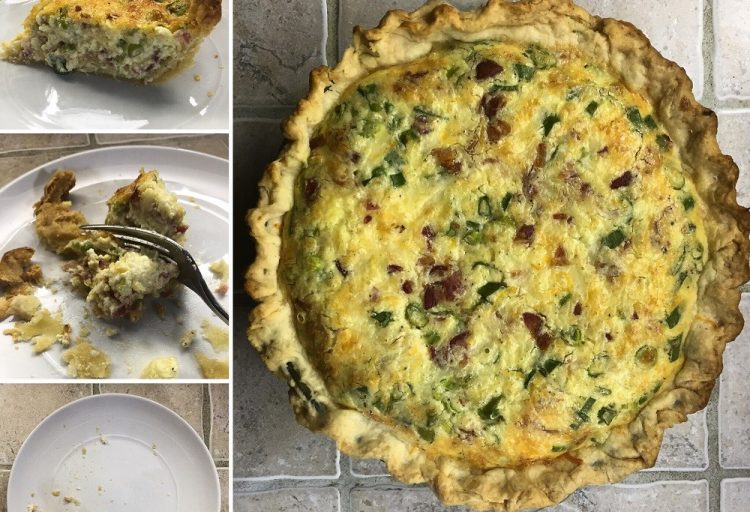Agnolotti (pronounced ahn-yuh-LAHT-tee) are rustic hand-filled pasta dumplings. I have found that these are the easiest filled pasta to make: they require no special tools or forms, and they’re much faster to make than individually-shaped pastas like tortellini or ravioli. Your first time making agnolotti might take a while, but once you understand the basics, you’ll be cranking these little dumplings out like a pro.
Butternut squash filling can often be cloying, tasting more like pumpkin pie than a savory dish. This filling is more like a brisk walk in the leaves than a warm mug by the fire. The caramelized onions give the filling another dimension, and thyme in place of the typical cinnamon/nutmeg combo keeps this dish from feeling like dessert. Add in a funky, garlicky gorgonzola sauce, and you’ll elevate your little pasta dumplings to four-star-restaurant status.

Although this recipe is something of a project, you can make the filling up to three days ahead of time, and you can fill the agnolotti up to a day ahead of time (or longer if you freeze them). You’ll need less than ten minutes at dinner time to boil the pasta and stir together the sauce. I’ve included a recipe for charcoal pasta if you want to make a Halloween-ready orange and black meal, but you can also use any regular pasta recipe (or just omit the charcoal). This serves 4-5 as a main course.
You’ll need:
For the pasta:
- 2 eggs
- 2 1/4-2 1/2 cups flour
- 1 T activated charcoal powder (optional)

For the filling:
- 1 1/4lb. butternut squash (half a medium squash)
- 1 bunch thyme
- 1 red onion
- 1 T kosher salt
- 1 t pepper
- 1/2 C ricotta cheese
- 1/2 lemon

For the sauce:
- 2 T butter
- 2 cloves garlic
- 4 oz. gorgonzola cheese
- 1 C whipping cream
Special equipment: Pasta machine (either the hand-crank kind or a mechanical one), pizza cutter or fluted pasta cutter
To make the pasta, add the eggs and charcoal powder to a mixer bowl and beat to combine.

Add the flour, and mix on the lowest setting, just until the dough comes together into a rough ball. You may need to add more flour if the dough is wet or sticky; if it won’t clump together, add a teaspoon of water at a time until it does.

Switch your paddle out for a dough hook and let it stir the dough on low for three minutes. If you don’t have a dough hook, you’ll need to knead the dough by hand. I really don’t recommend this, but it can be done! Make sure your surface is well floured and push away from you, then fold the dough in half and make a quarter turn. Repeat until the dough is soft and smooth, about ten minutes.

Wrap the dough in plastic wrap and set aside for 30 minutes to rest, or refrigerate up to 2 days.
Turn your oven on to 425F.

Peel and de-seed the squash and cut it into 1/2″ cubes. Take the papery peel off of the onion and cut it like an apple. Add both to a bowl along with a couple tablespoons of olive oil and the leaves from a few branches of thyme. Toss to combine, then scatter onto a sheet pan and sprinkle with salt and pepper. Roast for 12 minutes, then kind of flip and toss the veggies to turn them, and roast for another 12 minutes. Let cool about 10 minutes.


Scrape the veggies and herbs from the roasting pan into the bowl of a food processor. Add the ricotta, the zest and juice of the lemon half, and the leaves from a few branches of thyme. Pulse to combine, then process for a few seconds, until the mixture is smooth and incorporated. Scrape the orange mixture into a Ziplock bag or a piping bag and put in the fridge.

Now comes the fun part – shaping the agnolotti! It took me a bit of trial and error to figure out the best way to make these – my early agnolotti wouldn’t seal, split open, and leaked filling. But my pain is your gain, because only a few simple steps can make yours look professional on the first try.
Unwrap the pasta dough and cut it in half. Re-wrap one half and set it aside (if you do everything right, you should only need one half of the dough to finish this recipe; roll and cut the rest into fettucini and dry it for another day, if you’d like). Take half of the rest of the dough (1/4 of the whole) and roll it on a well-floured surface into a rectangle about 1/4″ thick and no wider than your pasta roller.

First, we’re going to run this little pasta piece through the fattest setting on your roller. Then dial your roller down two settings, and run it through again. Fold your pasta into thirds (take the short end and fold it in, then the other short end and fold it over like an envelope, to make three layers of dough).

Feed this through the fattest setting again, and repeat the process about 3-4 times, until your pasta is nice and soft. This helps to make your dough smoother and less prone to rip.
Once you’ve done this 3-4 times, you can stop with the folding step, and just run it through from the fattest setting to the second-thinnest setting. It should be almost 4 feet long at this point, and 4-5 inches wide. Dust your sheet with flour and lay it on a well-floured surface. Repeat the process with the other quarter of dough.

Find a clean sheet pan and dust it with flour (or semolina if you’re being fancy). You’ll put your finished agnolotti on this sheet to rest until it’s time to cook them.
Grab your bag of filling from the fridge. If it’s just a plastic bag, snip off the tip (you want about a 1/2″ opening). Pipe a line of filling down one long edge of your first sheet of pasta, about an inch from the edge. Don’t worry if it breaks a bit, you’re going to be shoving it around in there and it will settle out.

Fold the small edge over the filling, taking care to keep it close to the filling tube so you don’t get extra air in the finished agnolotti.

Press firmly with your fingers to seal the pasta to itself.( If you don’t get this nice and sealed, you will have a bad time.)

After sealing the pasta, you may want to check to make sure your pasta sheet isn’t sticking to the surface: carefully scrape underneath with a bench scraper or spatula, and add more flour between the pasta and the surface if necessary.
Once your tube is set, take your forefinger and thumb from each hand and pinch the filled tube together, with your fingers about 1 1/2-2″ apart. This seals the sides of the agnolotti. Make sure you’re pressing firmly on both sides of each filling pouch, sealing the pasta together.

It’s best to do this with two hands, all the way down the tube. When you’ve done this down the entire sheet, trim the long edge to within an inch and a half of the filled portion of the pasta (about the width of the filled part) with a fluted cutter (or just a pizza wheel).

Now you just need to make the final cut to shape the agnolotti. Grab your cutter and quickly and firmly cut through the middle of your sealed pinches, moving from the filled side to the edge side.


The cut will further seal the pasta, and when you run through the second side of each pouch, a fat little agnolotto will form as the filling flips onto the final edge of the pasta. Set the agnolotti aside on your floured sheet pan, seam side down.

Repeat the filling and forming process with the other sheet of dough.
At this point, you can put the pan of pasta in the fridge until you’re ready to make the sauce (up to a day). If you’re making the sauce now, you can just leave the pan out. The agnolotti can rest at room temp for up to a half hour while you clean up your mess and finish the sauce. Conversely, you can freeze them on the pan for a couple of hours, then remove them to a ziplock bag to freeze up to one month, just add a few minutes to their cooking time.
When you’re ready for dinner, set a large pot of salted water to boil (for the pasta) and make your sauce.
Mince the garlic while your butter melts in a sauce pan over medium heat. Add the garlic, stir, and let it cook about 30 seconds, then add the cream. Whisk together, then whisk occasionally until the cream starts to simmer. Add in the cheese and a few cranks of pepper, whisk to combine. Taste the sauce and add salt if necessary. Your sauce should thicken up when you add the cheese; turn the heat down to the lowest setting while you finish the pasta.

The water should be boiling; add your agnolotti to the pot, in batches if necessary, stirring briefly after adding them. Set a timer for 3 minutes. I like to serve this dish with the sauce on the bottom of the bowl, so I sauce the bowls just before I take out the pasta.
At about three minutes, they should be floating to the top. If not, add another minute. Once they’re floating, fish them out with a slotted spoon and distribute them into the bowls. Garnish the dishes with parmesan and thyme and serve immediately.

This dish isn’t fast or easy, but if you take it one step at a time, it’s extremely manageable. If you make the agnolotti ahead of time and pop them in the freezer, you can use as many as you need for quick and easy show-stoppers, weeknight dinners, or just a truly delicious dinner for yourself. After all of that work, you deserve it!






Leave a Reply